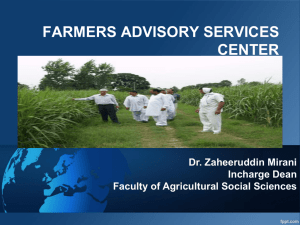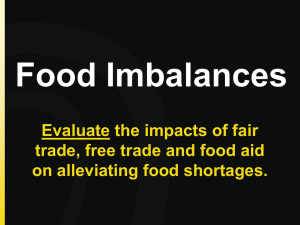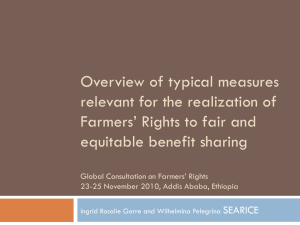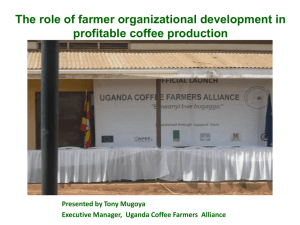farmer ownership model - Rural Finance Learning Center
advertisement
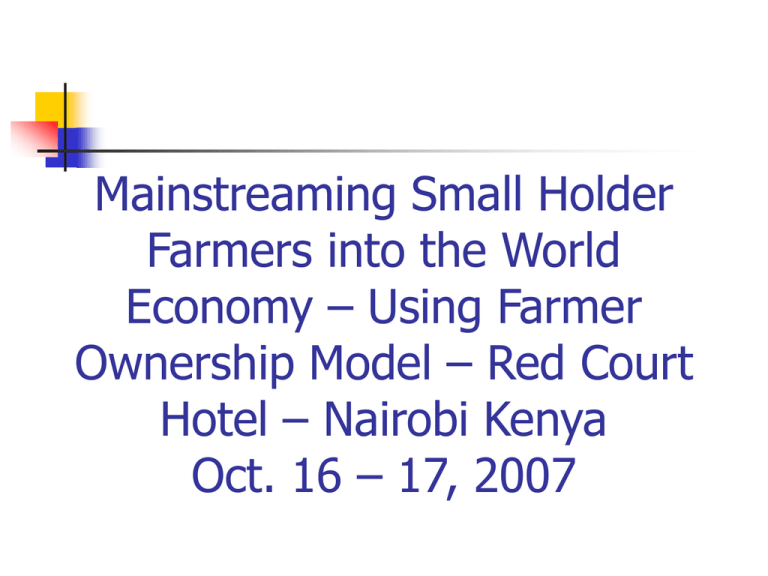
Mainstreaming Small Holder Farmers into the World Economy – Using Farmer Ownership Model – Red Court Hotel – Nairobi Kenya Oct. 16 – 17, 2007 Why Farmers are Poor They are in a poverty circle Small production for self consumption and small surplus for sale - money to buy basic items they do not produce (soap, paraffin oil, sugar, match box) They sell the small surplus at a give away price – exploited by middle men and become price takers (need for immediate cash) Why? For cash crops they sell as individuals, not adding value to justify the basis to negotiate and bargain for a better price For those farmers who are selling through cooperatives or associations they do not have the sense of ownership hence they surrender ownership to the managers and leaders who assume free ownership without investing on the production – Advance payment assumed to be the price of their crop, and additional payment is taken as manner from heaven Why? Small production because they cultivate a small piece of land using hand hoe technology They are not organized to apply the farming is business, pay on performance principles and benefit from group power They cannot access efficiently business facilitation tools (credit, inputs, skills, knowledge, appropriate technologies, market access, price and market information) Why? They are not marketing value added products at a negotiable and competitive prices, hence earning less. They cannot accumulate capital – to invest and increase production Lack of investment result to low production Low production - low incomes – low investments Reversing the Poverty Circle Organize farmers into business groups( 25 – 35 per group) using a strategic crops in a holistic, integrated and harmonized manner within the farming systems, and get their businesses names registered with the Registrar of Companies for legal backing (can be sued, sue, open bank accounts and enter into a contracts etc). Assist groups to profile their baseline and establish baseline data that will be used to develop vision based business plans and implementation strategies Assist groups to develop survival and Working Capital accumulation strategies How Capital is Accumulated Identify source, use of cash and deficit ( assist the groups to come up with simple cash flow statements and identify sources for financing their deficits. – borrowing (group guaranteed), development partners government) Identify immediate opportunities to improve cash generation and cash management (avoiding unnecessary expenditures) Initiate small savings mobilization schemes which will also enhance groups cohesiveness and having a sense of ownership. How? Groups lending to members to finance their immediate needs so that they can postpone individual sales of their produce at a give away price Encourage value addition by stopping selling to middle men and move higher to the nearest bigger market with bigger volumes Group marketing of all products for bargain power due to bigger volumes and value addition OUTPUT Increased income and savings More Farmers become members of groups as they learn from the others More value addition – moving to processing, packaging, labeling, export and internal market consumption promotion – price setters Establish traceability to the source of origin that can be certified or verified targeting niche markets i.e. fair trade, utz kapeh, organic, rainforest alliance etc. Farmers being active participants, profitably taking advantage or market liberalization policies and become part of the global economy Who are better positioned to Empower Stakeholder along the Supply Chain Private Sector Service Providers Who strongly believe that farmer and other stakeholders empowerment is a viable enterprise Willing to invest their own resources till positive results are achieved Should not have vested interest in the Chain (no ownership of the product or process) Willing to be paid on Performance (Value for Money) Opportunity to commercialize extension services which become part of the product cost Why Farmers Organization leaders, staff and gvt. officials cannot empower farmers “Lions cannot organize cows” due to conflict of interest – They have vested interest not necessary farmers’ interest in the process. It is not their job to organize farmers and have no capacity to do so They should play the role of facilitation, coordination, linking farmers to source of resources and provide enabling environment (legal, order, infrastructure and security) Leaders, staff and others are paid on performance (value for money) Role of Middlemen Becomes a facilitators, coordinators and providers of goods and services needed by the farmer as a result of increased purchasing power. Assume ownership based on the level of investments into the processes such as purchase and installation of machinery, value goods and services to be provided etc. Will no longer take ownership of commodities along the supply value chain Key for Success Attitude change by thinking in “we” instead of “me” - being smart greedy High level of trust, integrity, honesty, efficiency, commitment, determination, transparency and accountability within the chain Continuous flow of resources to empower the farmers and risks management till there is a complete real change Setting up “Innovative Rural Development Revolving Fund” funded and managed jointly by all key stakeholders. OUTCOME Minimize waste and misuse of resources Promote harmonization of use of resources and interventions (Farmers able to select who to work with and for what value) Paradigm shift “ Supply chain influencing the demand” Increased economy and efficiency Maximization of Farmers Income Wealth creation and Poverty eradication in very short period of time National Union of Coffee Agribusinesses and Farm Enterprises – (NUCAFE - Uganda) – Success Story Recognition and support from the Government of Uganda and its institutions Funding and support from International organizations Presence in all five growing regions in Uganda, have been able to work with 18,000 farmers to organize 600 farmer groups consisted of 30 farmers per group and these farmers were able to market a total of 1,200 m/tons of green coffee in the last 3 years Increased income of an average of 40% over equivalent green coffee at farm gate price 120 groups with bank accounts and savings averaging Ug Shs 360,000 per group. Market linkage fees collected amount to over UG Shs 10 million (US$ 6,000) Presented by: Herment A. Mrema Executive Director Africa Rural Development Support Initiative (ARUDESI P.O. Box 11415 Kampala Uganda Tel: 256 – 75 – 3- 301494/71-2-301494 Email: arudesiafrica@yahoo.co.uk hmrema@hotmail.com AHSANTE SANA THANK YOU



